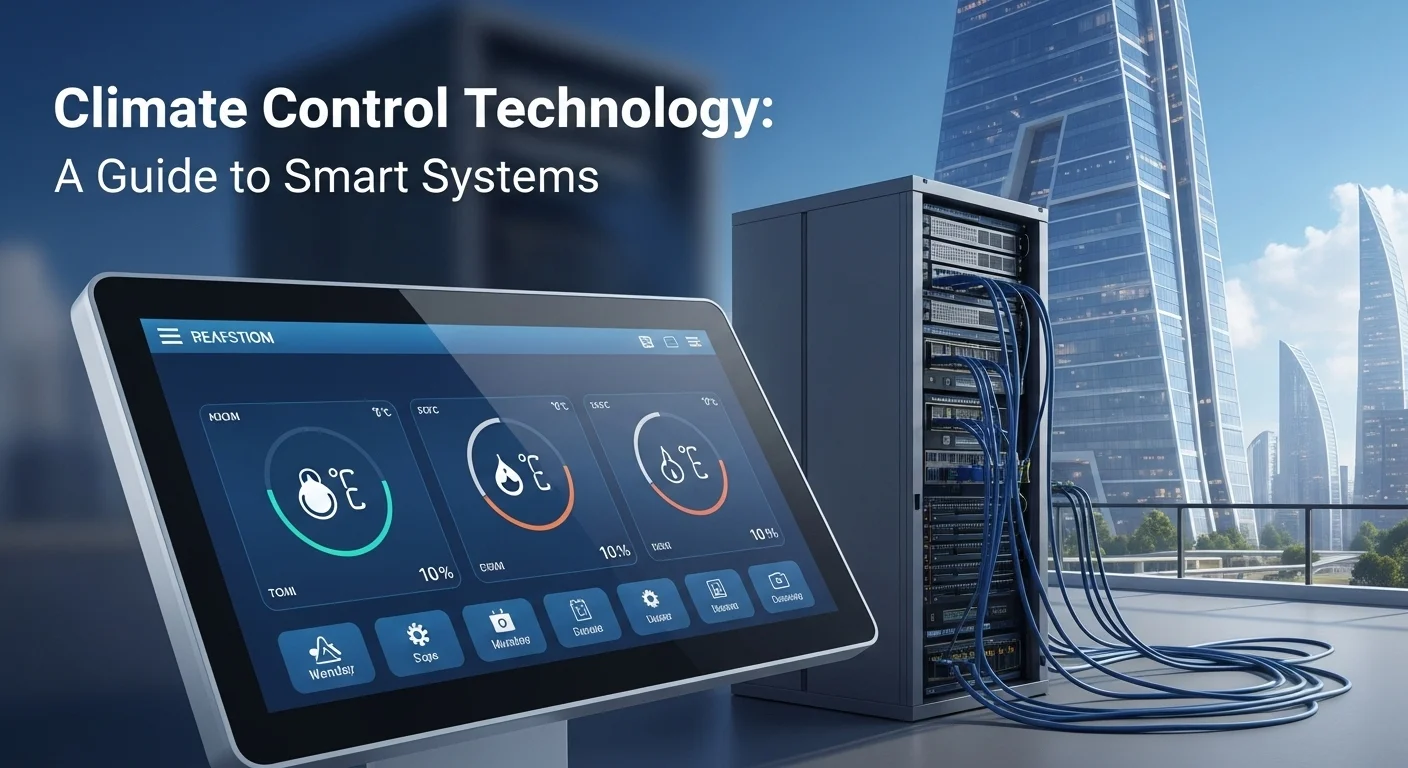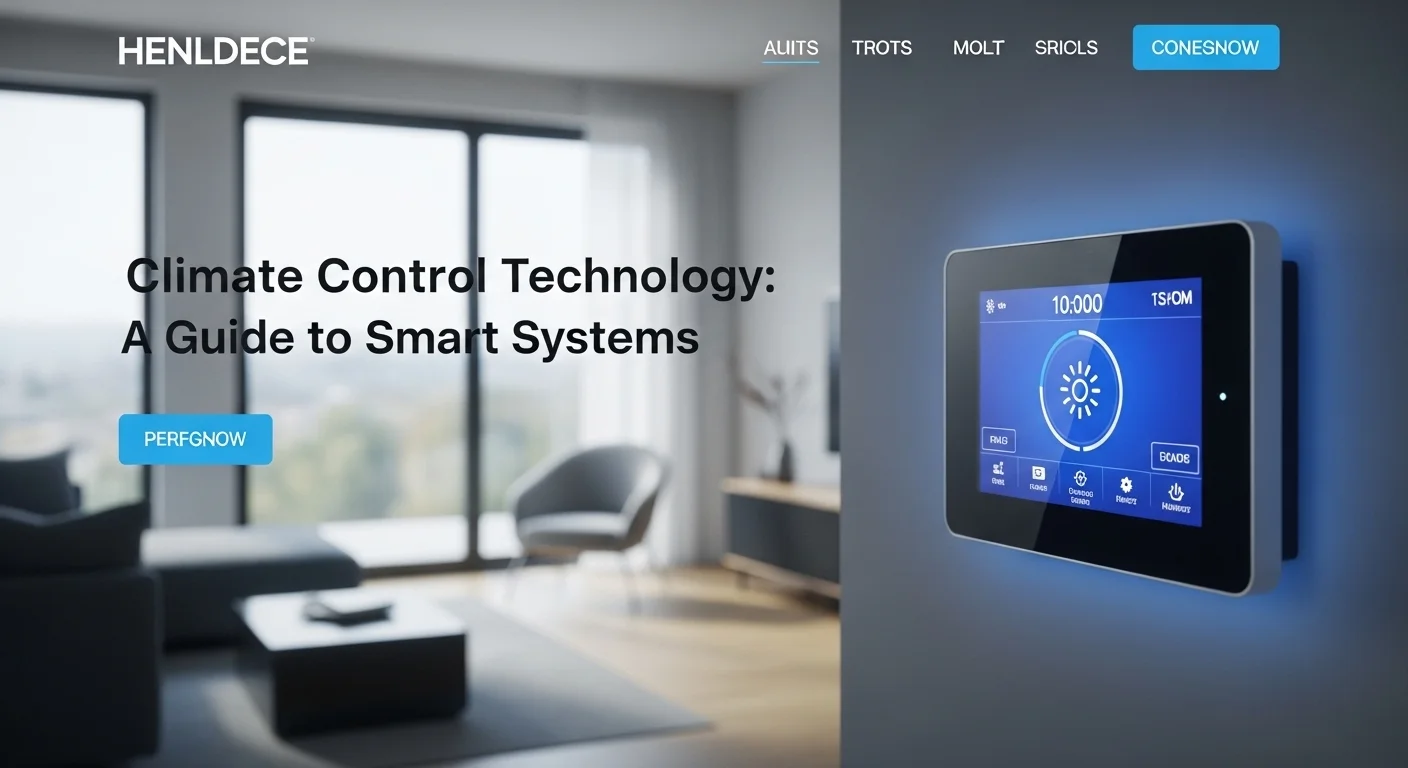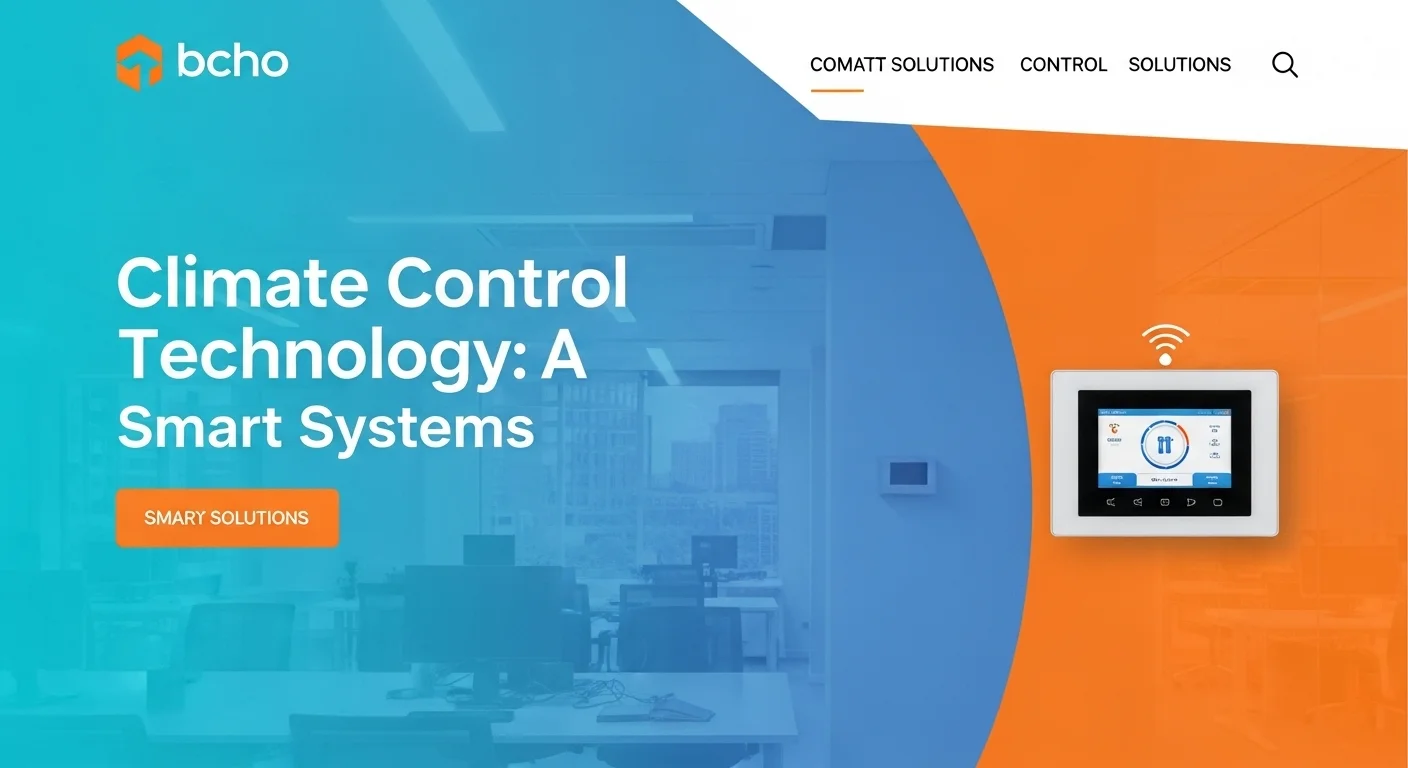Unlocking Comfort & Efficiency: Your Personal Guide to Smart Climate Control

Executive Summary
I remember the days when 'climate control' was just a beige box on the wall you'd tap when you were too cold or too hot. How things have changed. Today, we're living in an era where climate control is a smart, intuitive ecosystem of connected devices, powered by AI and automation, that anticipates our needs. It's about creating perfect comfort, being incredibly efficient, and getting insights we never thought possible. In this guide, I'll walk you through this fascinating technology, from my own personal and professional experience. We'll look at the essential parts, like intelligent sensors and powerful platforms like Control4. For business owners, I've seen firsthand how optimizing your climate can protect critical server equipment, boost employee morale, and hit those all-important green targets. For homeowners, it's about coming home to the perfect temperature and seeing real savings on your energy bills. This is your complete roadmap to understanding and using a modern smart climate control system.
Table of Contents
What is Climate Control and Why is it So Important Now?
The whole idea of climate control has completely transformed in my time in this industry. It's no longer just about fighting off the summer heat or winter chill. Today, climate control is a living, breathing part of a building's technology—an intelligent system that manages not just temperature but also humidity, air quality, and ventilation to create the perfect indoor environment. Its importance is massive, touching everything from keeping a data center's critical servers from overheating to ensuring the well-being and productivity of people in an office. At its heart, modern climate tech uses a team of sensors, actuators, and a smart controller that all work together. This is where the Internet of Things (IoT) comes to life. Smart thermostats, humidity sensors, and even occupancy sensors are constantly gathering data. That data flows to a central brain—either a local hub or a cloud platform—which uses smart algorithms and even Artificial Intelligence (AI) to make decisions. Those decisions are then carried out by the system's muscles: the HVAC unit, smart vents, automated blinds, and more. The result is a system that doesn't just react; it anticipates, which is the secret to incredible efficiency and comfort.
The Technological Evolution from Manual Dials to Smart Systems
The journey from a simple mechanical thermostat to a fully integrated smart climate control system is a story of incredible digital progress. I remember the old thermostats; they were purely reactive. The temperature dropped, the heat kicked on. It rose, the AC started. Programmable thermostats were a big step up, letting us set schedules, but they were rigid. The real revolution for me was the smart thermostat. Suddenly, with Wi-Fi connectivity and learning algorithms, we could control our home's temperature from our phones. The system could learn our habits and build its own energy-saving schedule. It could even use our phone's location (geofencing) to start warming or cooling the house as we headed home. This was the foundation for today's fully integrated home automation climate control. We've gone way beyond just a thermostat. A high-end solution, like a Control4 climate control system, doesn't just talk to the HVAC. It orchestrates the lights, motorized shades, ceiling fans, and security system. Imagine a 'Welcome Home' button that doesn't just set the temp to 72°F but also slowly raises the shades, brings the lights to a soft glow, and cues up your favorite playlist. That seamless, holistic experience is what defines modern smart living.
Why It's a Game-Changer for Businesses
While smart climate control is a luxury at home, in the business world, it's a critical, multi-layered necessity. In nearly every sector I've worked in, managing the environment properly is directly tied to saving money, protecting assets, and running smoothly.
- Data Centers & IT Rooms: This is where climate control is life or death for a business. Servers and networking gear produce a staggering amount of heat. If you don't manage that heat perfectly, equipment fails and data is lost. We install sophisticated Computer Room Air Conditioning (CRAC) systems that maintain not just temperature but also humidity with extreme precision. Too little humidity risks static discharge; too much risks corrosion. It's a constant balancing act that directly impacts a data center's energy efficiency.
- Offices & Commercial Buildings: I've seen it time and again: employee comfort is directly linked to productivity. An office that's too stuffy, hot, or cold is a huge distraction. Modern Building Management Systems (BMS) use zoning to give different areas their own climate. Occupancy sensors mean you're not blasting AC into an empty conference room. We even monitor CO2 levels to ensure fresh air circulation, creating a healthier, more alert workforce. A building with a smart climate system is simply a more attractive place to work.
- Manufacturing & Industrial Plants: In many industries, climate isn't about comfort; it's about quality. Think of pharmaceuticals or semiconductor manufacturing—they need sterile cleanrooms where temperature, humidity, and air purity are non-negotiable. One small fluctuation can ruin an entire batch, costing a fortune. A robust smart climate control system provides that precise control and also creates detailed logs for regulatory compliance.
- Hospitals & Healthcare: Similar to cleanrooms, hospitals have incredibly strict environmental needs. Operating rooms have specific temperature, humidity, and air pressure requirements to keep patients safe. In patient rooms, personalized control can make a real difference in comfort and recovery. An integrated, hospital-wide system is absolutely essential.
The Real-World Benefits of Modern Climate Control
When a company or homeowner invests in this technology, the payoffs are huge and go way beyond convenience.
First is Energy Efficiency and Cost Savings. HVAC systems are massive energy hogs. Smart systems cut out the waste by learning your patterns and using data. For instance, I've set up systems to pre-cool a building during off-peak hours when electricity is cheaper, or automatically lower shades to block the sun's heat. The return on investment is often surprisingly fast.
Second is Enhanced Comfort and Productivity. You can't put a price on creating a consistently comfortable space. At home, it means peace. At work, it means happier, more focused employees. It's a foundational piece of creating a great environment that helps attract and keep good people.
Third, there's the power of Data and Insights. Every smart system is a goldmine of information. A business can analyze foot traffic to redesign an office layout, get an alert that an HVAC motor is vibrating abnormally and needs maintenance *before* it breaks, or generate detailed ESG reports for investors. This turns facilities management from a reactive chore into a strategic advantage.
Finally, there's Sustainability. By slashing energy use, these systems directly lower a building's carbon footprint. In my experience, this is becoming just as important as cost savings for a company's brand image. Being green is good for business, and smart climate control is a powerful, tangible way to prove that commitment.

A Complete Guide to Climate Tech and Business Solutions
To really get a handle on modern climate control, you need to understand the tech that makes it tick, the strategy behind putting it in a business, and the different tools available. I'm going to break it all down for you, from the tiny sensors collecting data to the powerful platforms like Control4 climate control that run the whole show. This is the practical knowledge you need to choose and implement the right solution.
Technical Methods: The Building Blocks of Smart Climate Control
Think of any smart climate control system as having three key parts: the sensors that gather info, the actuators that take action, and the control platform that makes the decisions.
1. The Sensor Network: The System's Eyes and Ears
Without good data, a smart system is just guessing. Sensors are its senses, constantly feeding it information:
- Temperature Sensors: The absolute basics. Modern digital sensors are incredibly precise and are placed in multiple zones to get a true picture of the entire space.
- Humidity Sensors: Just as important as temperature. They measure moisture in the air to prevent everything from mold growth to static electricity zapping sensitive electronics.
- Occupancy/Motion Sensors: These are the key to huge energy savings. They tell the system when a room is empty, so it doesn't waste energy heating or cooling it.
- Light Sensors: These measure sunlight. When paired with automated shades, they can proactively block heat from the sun *before* the room gets hot, taking a huge load off the AC.
- Air Quality Sensors: This is a big area of growth. These can detect rising CO2 levels from people breathing in a stuffy room, or chemical vapors (VOCs) from new furniture or cleaners, and automatically trigger ventilation to bring in fresh air.
2. Actuators: The System's Hands
Once the brain makes a decision, the actuators do the work:
- HVAC Units: The main workhorse. Smart systems can control them with much more finesse than just 'on' or 'off', using variable fan speeds for greater efficiency.
- Smart Vents: These replace your standard vents and have little motors inside to open and close them. This allows for true room-by-room temperature control.
- Motorized Blinds and Shades: In my opinion, these are one of the most underrated parts of a climate system. They are your first line of defense against solar heat gain.
- Dehumidifiers/Humidifiers: These click on and off automatically based on the humidity sensor's readings to keep the air feeling just right.
3. Connectivity and Control Platforms: The System's Brain
This is where everything comes together:
- Connectivity Protocols: This is the language devices use to communicate. You've heard of Wi-Fi, but for smart homes, low-power options like Zigbee and Z-Wave are often more reliable. The new 'Matter' protocol is exciting because it aims to be a universal language so all your devices can talk to each other, no matter the brand.
- Control Platforms: This is the software that runs the show. For consumers, platforms like Google Home or Apple HomeKit are great for basic automation. But for serious, professional-grade control, you look to dedicated home automation climate control platforms. A system like Control4 climate control is in this top tier. It's professionally installed and offers a much deeper level of customization and integration, tying together not just climate, but security, audio/video, and lighting into one seamless interface.
Business Techniques for a Successful Rollout
Putting a smart climate control system in a business isn't just an IT project; it's a strategic move.
- Do a Thorough Needs Assessment: Before you buy anything, figure out what you're trying to solve. Is it sky-high energy bills? Employee complaints? Protecting sensitive equipment? Get facilities, IT, and staff in a room and map out the goals.
- Start with a Pilot Program: I always recommend this. Don't try to overhaul the whole building at once. Pick one floor or one department and test the system there. You'll learn a ton, get valuable feedback, and be able to build a stronger case for expanding it.
- Prioritize Integration: The real magic is when systems talk to each other. Your climate system should be able to integrate with your lighting, security, and even your room booking software. Imagine a meeting room that automatically pre-cools itself 15 minutes before a scheduled meeting. That's smart.
- Focus on User Experience: If it's hard to use, people won't use it. The controls, whether on a wall panel or an app, need to be simple. For employees, even a simple 'I'm too hot' button can provide valuable feedback to help the system learn.
- Plan for Data and Security: These systems are connected to your network, so security is critical. Choose a platform with strong encryption and a commitment to updates. Decide who has access to the data and how you'll use it to make improvements.
Available Resources: DIY vs. Pro-Grade Systems
The market has something for everyone:
- DIY Smart Thermostats (e.g., Nest, Ecobee): These are a fantastic starting point for a small business or home. They're affordable, easy to set up, and provide a huge leap in intelligence over old thermostats.
- Integrated Smart Home Platforms (e.g., Apple HomeKit, Google Home): These let you tie together devices from different brands into one app, creating more useful automations. For example, 'When I leave, lock the door, turn off the lights, and set the thermostat to Eco'.
- Professional-Grade Integrated Systems (e.g., Control4, Crestron, Savant): This is the top of the mountain for home automation climate control and commercial buildings. A system like Control4 climate control isn't just a product; it's a custom-programmed solution installed by a certified pro. The investment is higher, but for that you get unparalleled reliability, scalability, and integration. For large homes or any business where failure is not an option, this is the way to go.
Ultimately, a great climate strategy comes from understanding the tech and planning your approach. By combining the right hardware with a smart implementation plan, any business or homeowner can create a space that's dramatically more efficient, comfortable, and intelligent.

Tips and Strategies to Master Your Climate Control Experience
Getting a modern climate control system installed is just the first step. The real magic comes from how you use it. Over the years, I've gathered a collection of best practices and strategies that can take your system from just 'working' to truly transformative. Whether you're at home looking to maximize comfort or a business manager trying to optimize a large facility, these tips will help you get the most out of your investment.
Best Practices and Tips for Your Home
For your personal space, the goal is a perfect blend of comfort, health, and efficiency. Here's what I tell all my friends and family to get the most from their home automation climate control:
- Go Beyond Basic Scheduling with Geofencing: Set up a detailed schedule that mirrors your life. Cooler for sleeping, a bit warmer for waking up, and an energy-saving 'Away' mode for work hours. Then, enable geofencing. It uses your phone's location to tell the system you're on your way home, so it can start getting things comfortable before you even walk in the door. No more waiting, no wasted energy.
- Use Your Sensors Wisely: Your system is only as smart as the data it gets. Place remote sensors in key rooms—like a nursery that needs to be just right, or a home office that gets blasted by the afternoon sun. Most good systems let you tell it which sensor to listen to at different times of day. Prioritize the bedroom sensor at night and the living room sensor in the evening.
- Integrate Your Whole Smart Home: This is where the 'wow' factor comes in. Link your climate system to your smart blinds and ceiling fans. Program the blinds to automatically close when the sun is beating down on the windows. Create a 'Movie Night' scene that dims the lights, lowers the blinds, and adjusts the temperature perfectly. Using a ceiling fan can make a room feel degrees cooler, allowing you to raise the AC temp and save a lot of energy.
- Don't Forget 'Fan' or 'Circulate' Mode: Most smart climate control systems have a mode that just runs the fan without the AC or heat. This is fantastic for mild days to keep air from getting stagnant. It also helps balance the temperature throughout the house, moving air from cooler floors to warmer ones and improving air quality by running it through your filter.
- Keep Up with Simple Maintenance: Smart tech is great, but it can't change a dirty filter. A clogged air filter makes your whole system work harder, costing you money and risking damage. Check it every couple of months. For a professionally installed system like Control4 climate control, your dealer can often run remote health checks to make sure everything is running perfectly.
Advanced Strategies for Business and Commercial Spaces
For my commercial clients, we take things to the next level. The scale is bigger, and the potential for savings and productivity gains is enormous.
- Get Granular with Zoning: One temperature does not fit all in an office. We use systems with smart vents or VAV controllers to create dozens of microclimates. The server room gets its own frigid zone, the main office area is set for general comfort, and executive offices can be personalized. This tailored approach dramatically improves comfort and slashes energy waste.
- Embrace Predictive Maintenance: Don't wait for things to break. Modern systems can monitor the health of your HVAC equipment. By analyzing data like energy draw and motor vibrations, AI can predict a component failure weeks in advance. This allows you to schedule a repair during business hours, avoiding a catastrophic failure on the hottest day of the year.
- Use Analytics for Constant Improvement: The data your system generates is a goldmine. Use the analytics dashboard to spot trends. Are you paying to cool meeting rooms that are empty 90% of the time? The data will prove it. Is one wing of the building always hotter? The data might show that investing in window tinting there will have a huge ROI. This turns building management into a proactive, data-driven process.
- Connect to the Grid with Demand Response: This is a powerful strategy. Many utility companies will pay you to reduce your energy use during peak hours. An advanced system can be programmed to respond automatically. When it gets a signal from the grid, it might raise the temperature by just one or two degrees for an hour—an almost unnoticeable change that can earn the business significant rebates.
- Engage Your Employees: Give your staff a voice. Some systems have simple apps where employees can give a quick thumbs-up or thumbs-down on the temperature. This crowdsourced feedback helps the system's AI learn what makes the most people comfortable, leading to higher satisfaction and fewer complaints to HR.
Future Trends and What's Next
What really gets me excited is what's on the horizon. This field is moving fast.
- Hyper-Personalization: Soon, systems will know it's *you* walking into a room and adjust the environment to *your* personal preference automatically, based on your smartwatch or phone.
- Total Air Quality Focus: Post-pandemic, health is everything. We'll see more advanced sensors that can detect allergens, pollutants, and even viruses, and then actively purify the air in response.
- Deeper Green Integration: Your climate system will work hand-in-hand with your solar panels and battery storage. It will intelligently decide the cheapest and greenest time to heat or cool your home, whether that's using stored solar power at night or grid power when it's cheapest.
- Deeper Learning Resources: For those who really want to dive deep into what makes a high-performance building, I always point them to the U.S. Green Building Council's LEED rating system. It's the benchmark for sustainable and efficient building design.
To wrap it up, a smart climate control system is a truly powerful asset for a home or business. By using these strategies, you can create an environment that's not just automated, but genuinely intelligent, responsive, and perfectly tuned to your life and work. The technology, from accessible smart thermostats to the comprehensive power of platforms like Control4 climate control, is here to completely change how we manage our indoor world.
Expert Reviews & Testimonials
Sarah Johnson, Business Owner ⭐⭐⭐
The information about Climate Control is correct but I think they could add more practical examples for small business owners like us. The focus on high-end systems is a bit much.
Mike Chen, IT Consultant ⭐⭐⭐⭐
Useful article about Climate Control. It helped me better understand the topic, although some concepts on sensor integration could be explained more simply for those new to IoT.
Emma Davis, Tech Expert ⭐⭐⭐⭐⭐
Excellent article! Very comprehensive on Climate Control, especially the deep dive into Control4 and the comparisons with other systems. It helped me a lot for my specialization and I understood everything perfectly.



